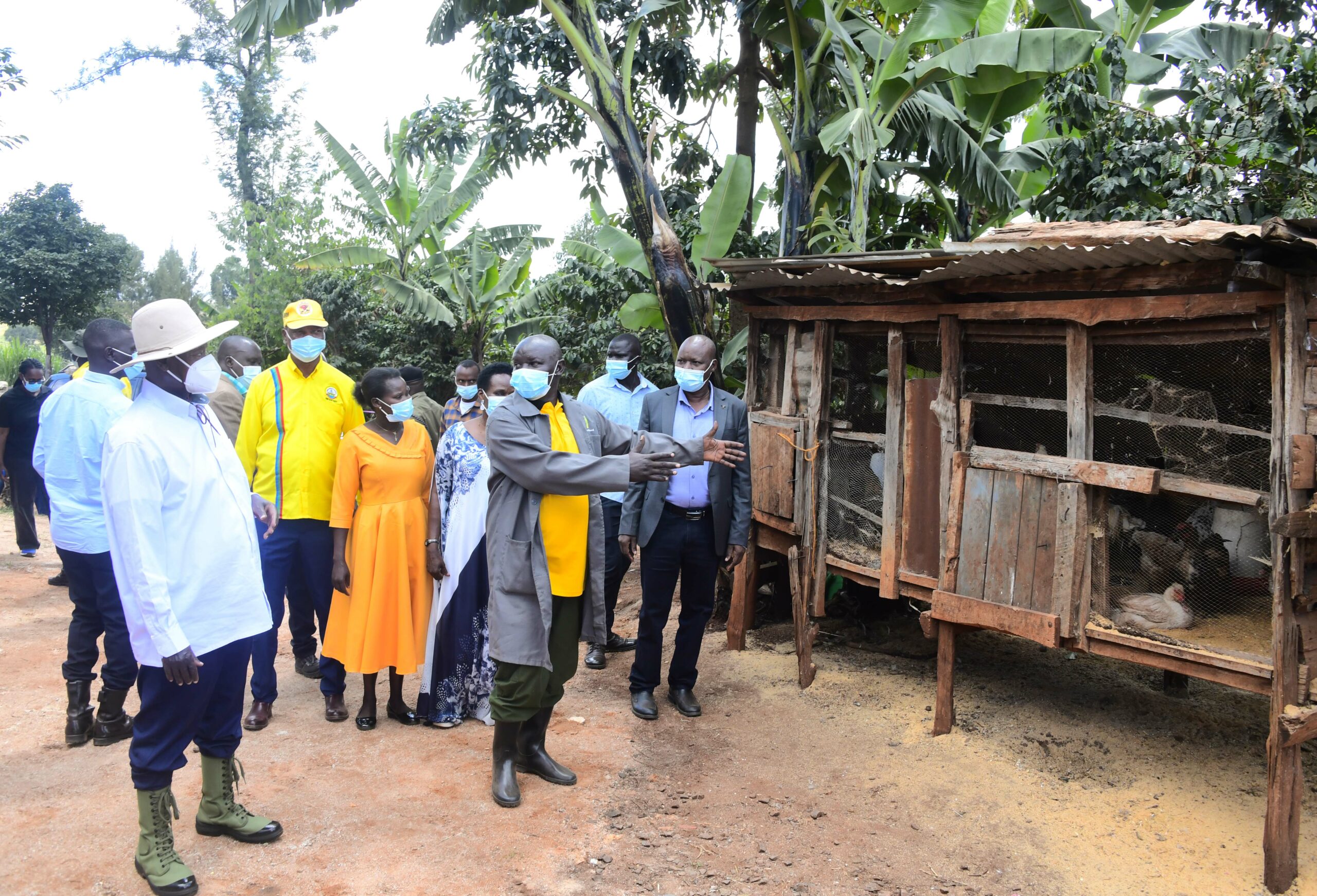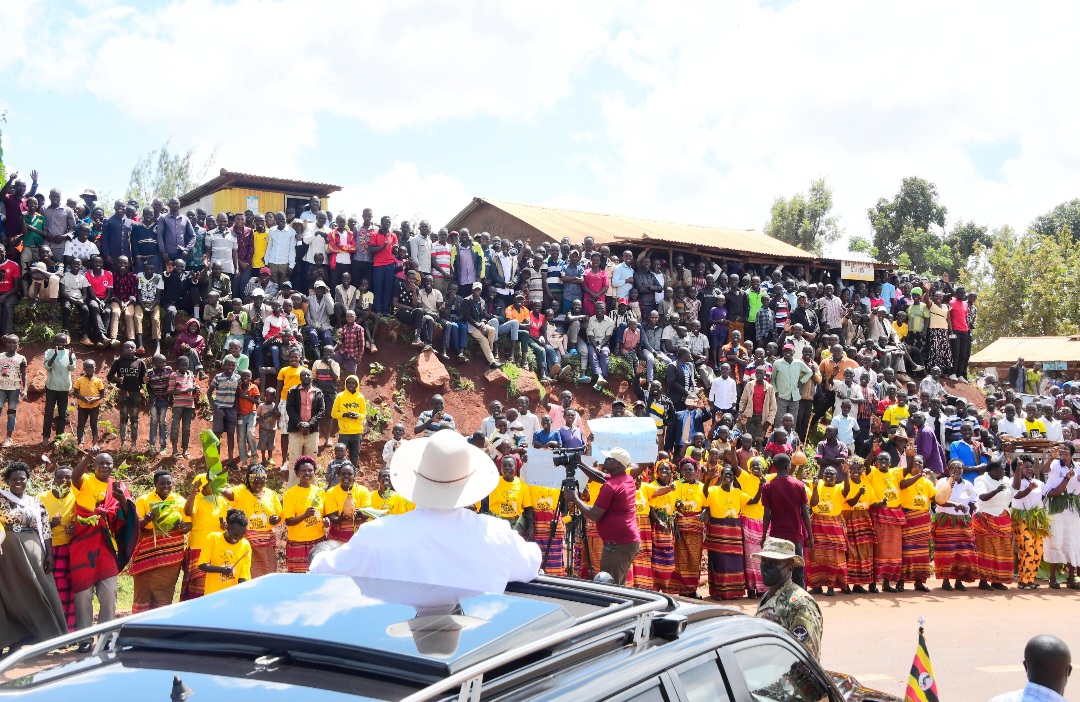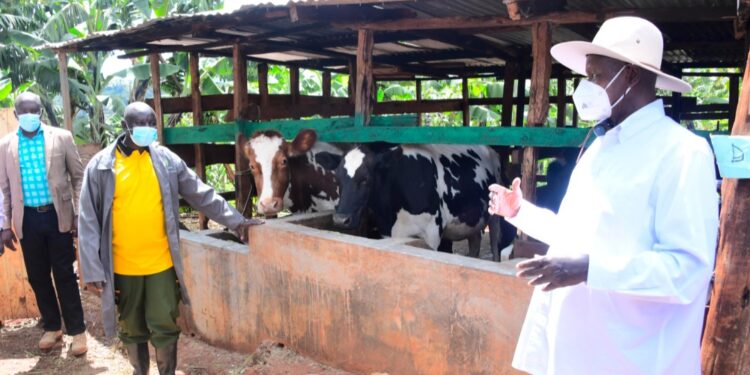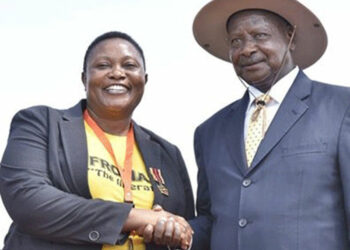President Yoweri Kaguta Museveni has commended farmers in the Sebei subregion for adopting the Four-Acre Model, a strategy designed to maximize land productivity and improve household incomes.
During his visit to Bukwo District today, the President praised the farmers for heeding his call to diversify their activities on small plots of land to enhance both food security and economic sustainability.
He made the remarks while at the home of Mr. Nicholas Chelimo, a model farmer in Ngeny Village, Kapkoros Parish in Bukwo district.
President Museveni today commenced his three-day wealth creation and Parish Development Model (PDM) performance assessment tour in the Sebei sub region which is scheduled to end on December 12, 2024.
“I am very glad to see people waking up. Wherever I go, I see people making progress. This is exactly where we came from. In 1986 when I first visited here in the Sebei region ,I found that people were hardworking, but they were working without “Ekibaro” (calculation),” he said.
“They would grow maize, which would only last nine months. First of all, maize is a very low-value crop unless you grow it on a large scale. If you grow it on a small scale, you won’t get money, and that was the problem across the whole country.”

The President explained the National Resistance Movement (NRM)’s efforts to educate Ugandans on aligning agricultural practices with land sizes and needs.
“NRM taught you that there are two types of agriculture: extensive and intensive. Extensive agriculture involves growing products like maize and cotton on a big scale. These products don’t give high income per acre, but if you do them on a large scale, you will get both food and money. For example, much of the animal feed comes from maize, so you can’t do farming for poultry, piggery, or even cows without maize,” he said.
“If a farmer cultivates 1,000 acres of maize, they can earn significant money, even a billion shillings. The same applies to crops like sugarcane. If you grow ten acres, you get ten million; if you grow 100 acres, you get 100 million. These crops require scale to be profitable,” he added.
The President also addressed the challenges of small landholdings and the solutions designed for such farmers.
“Because many people have small land, we had to design another approach, the four-acre model. This model recommends seven activities. One acre should be for coffee, another for fruits. In cold areas like Kapchorwa, high-value crops like apples and grapes can do very well. These are imported from South Africa, yet they can be grown here.In warmer areas, you can grow mangoes, pineapples, and oranges,” he said.
“The third acre should be for pasture, and the fourth for food crops for your family. For the backyard, we advise poultry for eggs, which doesn’t require much space, and piggery. Those near wetlands should do fish farming not in the center of the swamp but at the edges.”
On irrigation, President Museveni stressed its importance and the need for water conservation.

“We need irrigation, but where will you get the water if you are wasting the wetlands? For areas like Kapchorwa and Mt. Elgon irrigation can be easily upscaled and expanded,” the President noted.
“In Bushenyi, we have seen how transformative it is. Dr. Muranga, a scientist working with bananas, has applied irrigation and now harvests 53 tonnes per hectare, compared to the 5.3 tonnes harvested by the neighboring Banyankole. In Brazil, I am told they go up to 80 tonnes per hectare. Clearly, irrigation is a game-changer,” he said.
On the other hand , at 54 years old, Mr. Chelimo, a father of seven, is a living testament to how modern agricultural practices can transform lives.
Starting with only two acres of maize inherited from his father, Mr. Chelimo has turned his farm into a thriving enterprise, practicing zero grazing, banana farming, coffee cultivation, maize production, and local poultry farming.
“In 2000, I only had two acres of maize planted on open ground. That was all I inherited from my father,” Mr. Chelimo recalls.
“For years, it was difficult to make significant progress. But everything changed in 2019 when I got the President’s message on the four-acre model from television,”he noted.
Inspired by President Museveni’s guidance, Mr. Chelimo expanded his farm by acquiring two additional acres, bringing his total to four.
He diversified his farming activities and introduced coffee cultivation.
“I planted coffee, which has been a game-changer for me. Last year, I produced 800 kilograms of Arabica coffee, and I am projecting 1,000 kilograms from an acre this year,” he proudly said.
Mr. Chelimo’s commitment to learning and improving his techniques took him to President Museveni’s model farm in Kawumu in 2019.
“Visiting the farm in Kawumu opened my eyes to the possibilities of modern farming. I also adopted a biogas system, which has made my farm more sustainable,” he shared.
With three cows, a productive coffee plantation, and diversified crops, Mr. Chelimo has secured his family’s livelihood and created employment opportunities.
“I now have two permanent employees working on my farm. Today, I earn a net income of 30 million shillings per year, which is far more than what I make as a teacher,” said Mr. Chelimo, who has been a senior teacher at St. Joseph’s Secondary School in Bukwo for over 30 years.
Reflecting on his journey, Mr. Chelimo encouraged other farmers to adopt the four-acre model and embrace modern farming techniques.
“The four-acre model has truly transformed my life. It’s a solution for smallholder farmers to maximize income while ensuring food security,” he advised.
The event was also attended by local leaders and the family of Mr. Chelimo.
Do you have a story in your community or an opinion to share with us: Email us at editorial@watchdoguganda.com










